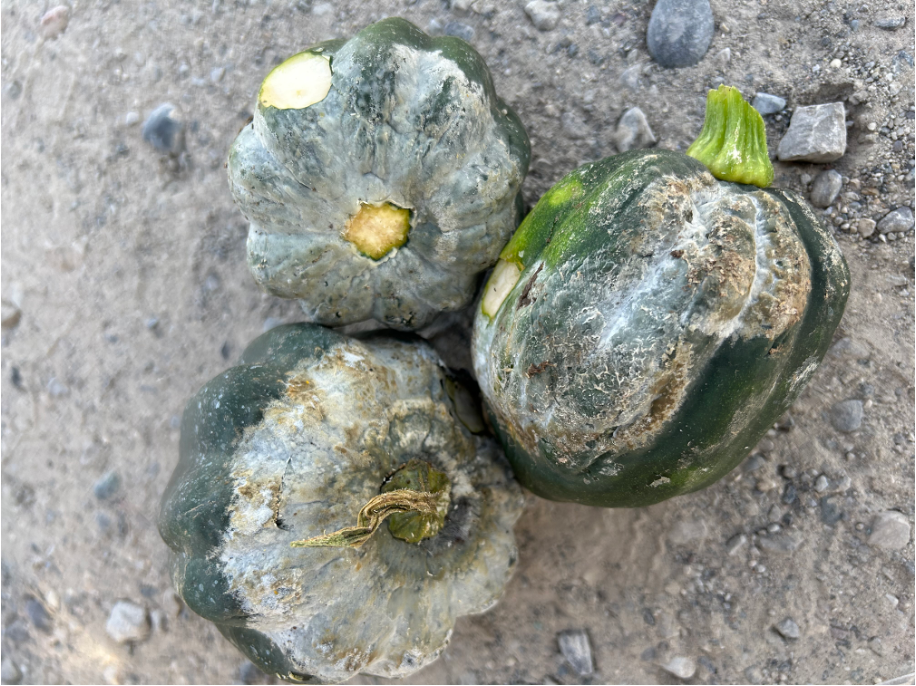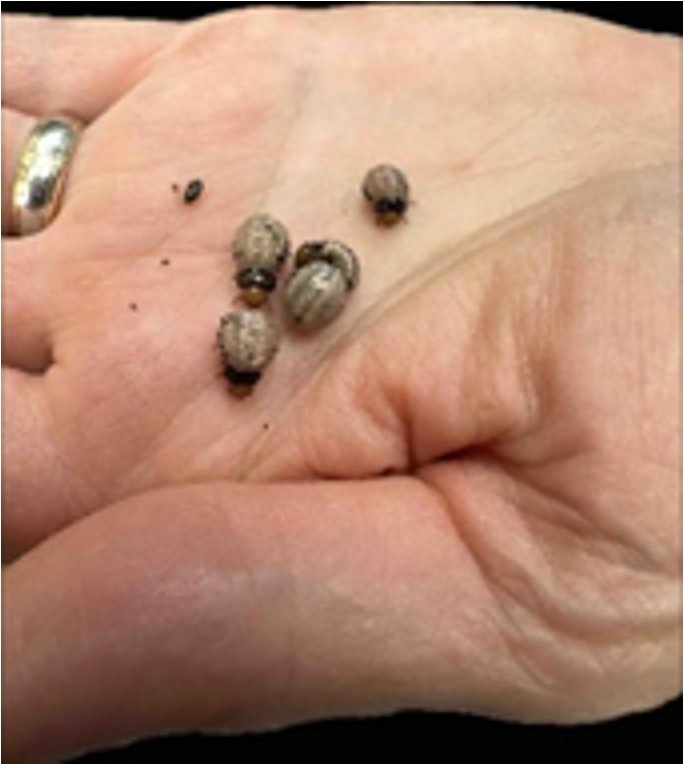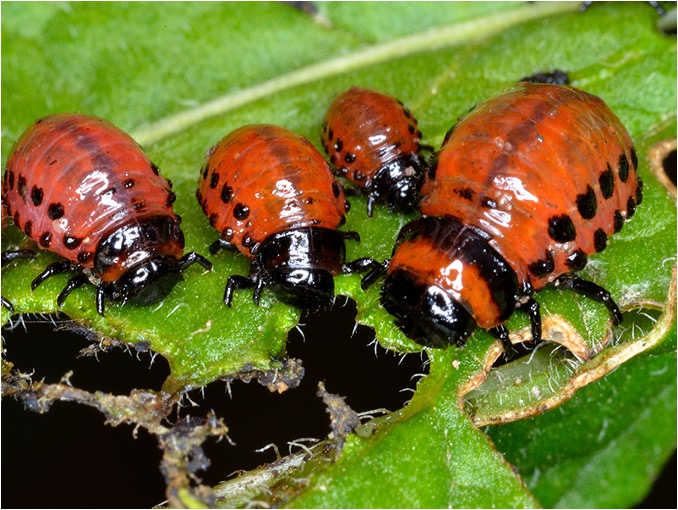Michigan vegetable crop report – July 23, 2024
The past week was cooler than normal and mostly dry, except for heavy rain in southwest Michigan

Weather
The past week was cooler than normal and mostly dry, except for heavy rain in southwest Michigan. Looking back a bit more, temperatures have been close to normal for most of July. Degree-day totals for the Lower Peninsula are still several days to a week ahead of normal. We have reached the time of year when temperatures are highest, as daylengths continue to decrease late summer temperatures tend to cool.
The forecast for this week predicts:
- Variably cloudy with scattered showers and thunderstorms likely north Tuesday (July 23), spreading south into central and southern areas of the state by Wednesday morning.
- Fair, dry and cooler Thursday and Friday followed by a warming trend into the weekend. Showers and thunderstorms possible again by Monday and Tuesday of next week.
- High temperatures from the low 70s north to mid-80s south Tuesday, cooling to the 70s Thursday and Friday warming back into the 80s this weekend. Low temperatures in the 60s Wednesday morning falling to the 50s through Saturday and then warming back to the 60s by early next week.
- Normal to slightly above normal daily potential evapotranspiration (PET) rates expected this week (daily values from 0.16-0.20 inches).
- Medium and long-range outlooks generally call for above normal temperatures. Above normal precipitation totals are also expected into early August.
- Precipitation totaling 0.5-0.75 inches or less from scattered rains.
Nutrient management survey
Soil nutrient deficiencies that limit crop yield are often foremost on farmer’s minds but nutrient excesses, especially phosphorus and nitrogen, seem to grab the headlines. Since Michigan is surrounded by our five Great Lakes which ultimately receive any excess soil nutrients, there is an urgent need to identify best practices which feed crops adequately without adding to nutrient loading in the Lakes. Variation in soil type, soil texture, crops and cover crops grown, and crop rotations can have a huge impact on effectiveness of soil nutrient management practices.
Vicki Morrone in the Department of Natural Resources at Michigan State University (MSU) is part of a team evaluating the relationship among soil type, crops grown and practices used to manage soil phosphorus and nitrogen. She is asking farmers from all types of production systems to help identify practices they use by filling out a brief anonymous online survey describing soil conditions and approaches used for soil phosphorus and nitrogen management. The information shared will help identify promising approaches for researchers to test on different soil types and with different field crop, vegetable, fruit and pasture rotations.
The survey will take about 15 minutes to complete, and everyone who completes it can be entered into a drawing for MSU hoodies. The deadline to take the survey is Nov. 1, 2024. Winners will be announced Dec. 1, 2024, and mailed their prize. This work is funded by the United States Department of Agriculture National Institute of Food and Agriculture. If you have questions, please email Vicki Morrone at sorrone@msu.edu.
Access the confidential survey
Produce Food Safety On-Farm Readiness Reviews
On May 2, the U.S. Food and Drug Administration (FDA) released their final revisions to the Food Safety Modernization Act Produce Safety Rule Pre-Harvest Agricultural Water Rule. If you are a grower in Michigan, this is a great time to schedule an On-Farm Readiness Review (OFRR). Not only can our team help you assess your on-farm produce safety risks, we can help you assess your water system in light of the updated water rule. If you have already had an OFRR on your farm, no problem, we are happy to come back out to help you assess your water system based on the new parts of the water rule.
An On-Farm Readiness Review (OFRR) is an opportunity for a grower to walk around their farm with their local conservation district produce safety technician and a produce safety specialist from Michigan State University Extension. These 2-hour educational visits take place during the harvest season and are meant to be casual and low stress. Everything discussed during an OFRR is confidential and focused on ways a grower can reduce their own risks in relation to produce safety. There is no pressure to take our advice either, we are just here to support you in your produce safety efforts!
Crop updates
Asparagus
Growers are taking care of asparagus beetles and Japanese beetle where they are popping up and continuing fern fungicide applications. For purple spot, between 4-9 disease severity values (DSVs) accumulated at six sensors Michigan State University Extension is monitoring from July 16-22.
Brassicas and greens
Broccoli, kohlrabi, some cabbage, kale and salad mixes of all types are flowing into markets with new plantings being established. All caterpillars and beetles can be found, with thrips as well in some situations.
Black rot is an economically important bacterial disease of cabbage and other cole crops. The pathogen can enter the crop through hydrathodes, the pores on the edge of leaves where water is lost during guttation. Thus initial yellowing and necrosis starts from the leaf margins and moves in. It is primarily a seedborne disease, so using tested seed from reputable sources is a major step in keeping the pathogen out. Growers have also found success disinfecting seeds with hot water prior to planting. This disease can also survive on leftover crop residues or brassica weeds, so the usual best practices of keeping your fields clean and free of inoculum sources can also go a long way. For a deeper dive, check out this Ontario Ministry of Agriculture article on the topic.
Carrots and celery
Celery scouts reported isolated damage from celery leaftier and tarnished plant bug this past week. Variegated cutworm may also be active. Pyrethroids including Baythroid (zero-day preharvest interval, or PHI) and Mustang Maxx (one-day PHI) carry both caterpillars and tarnished plant bugs on their label.
The TomCast disease forecaster can be used to time fungicide applications to protect the tops of carrots from foliar disease. For the past week, 6 DSVs accumulated at two sensors MSU is monitoring. A fungicide application is warranted when 15 DSVs accumulate since the last application. Daily values can also be a helpful guide. Each day gets a DSV ranging from 0 (least favorable for disease) to 4 (extremely favorable). When your report shows a stretch that includes 3s, it could be especially important to use a highly effective, locally systemic fungicide.
Symptoms of aster yellows continue to be present in carrots. For information on aster leafhopper thresholds and aster yellow infectivity risk, check out this recent article from Zsofia Szendrei and consider signing up for the text alert system.
Cucurbits
All crops are being harvested, except pumpkins. Watermelons are still building in volume. Mechanical pickle harvests are stacking up.
The downy mildew that affects melons and cucumbers has been confirmed in the main pickle production regions of Michigan and is likely well-distributed. At this time, it appears that pumpkins, squash and watermelon are not at high risk for infection. Protective fungicides are important for this disease, and it may be advisable to shorten spray application intervals to protect vulnerable crops during wet and humid periods as this pathogen can be explosive when the weather is favorable. As an easily spreadable community disease, timely crop destruction is also important after harvest or when a field needs to be abandoned. Growers on bare soil may find it easiest to disc in the remaining crop residue, while growers on plastic mulch are better off using a fast-acting burndown herbicide like paraquat or pelargonic acid. See the MSU Extension news story containing fungicide recommendations for 2024. Keep up to date on the development of this destructive cucurbit disease at the Hausbeck Downy Mildew News website.
A related pathogen is also active right now, called Phytophthora capsici. Many Michigan producers experience significant losses in squash and cucumber from that pathogen following heavy rains. The most obvious symptoms are entire plant wilts, and regions of white spores on the surface of fruits that look similar to powdered sugar. The best way to protect crops from Phytophthora is to do everything you can to prevent it from being introduced to a new area, and to apply recommended fungicides before an outbreak. If you know you have a history of the pathogen on a parcel of land, then you’ve got the upper hand. Several fungicides are registered for use on cucumber, hard squash and pumpkin. Rotate fungicides to prevent the pathogen from becoming resistant.
If Phytophthora symptoms develop, crop destruction is important as it takes away the “food” that the pathogen needs to reproduce. Disc the diseased plants and the surrounding, healthy-looking border plants and power wash the equipment to prevent spread to other areas. This Phytophthora pathogen can spread from field to field via soil particles clinging to field equipment, and from pitching rotty produce bought from somewhere else into the field. Work problem fields last, and discard diseased fruit in an area where crops will not be grown in the future.
Many hard squash and pumpkin plants produce large, dense canopies and proper application equipment is often required to achieve adequate protection of the fruits. Air-assisted nozzles will push the fungicide through the canopy more effectively than conventional nozzles. Using a higher volume of water when spraying can also assist with the penetration of the fungicides into the canopy.

Fruiting vegetables
Harvest volumes are building. Slug and caterpillar feeding is being found in tomatoes.
Growers should be on top of their fungicides to control bacterial leaf spot and Phytophthora crown rot. Bacterial leaf spot is evident in some plantings. Copper applications could help to protect the fruit from the blistering caused by the bacterium. Severely infected pepper plants will drop the infected leaves which can result in sunburn of the fruit. Similar to the vine crops, whose whole vines and fruit melt down from Phytophthora capsici, peppers will wilt from crown infection, and both tomato and pepper fruits that touch the ground will rot. MSU field research has conclusively shown that effective fungicides must be applied via drip in order to maximize efficacy in peppers. Unstaked tomatoes would benefit from the same approach taken to protect vine crops (see above).
Another different Phytophthora pathogen, late blight, has developed on potato and tomato in Ontario, which could have important implications for Michigan tomato growers. The pathogen is called Phytophthora infestans and symptoms include blighting on all aboveground parts of the tomato plant. Lesions on leaves often appear dark and oily with production of sporangia (seeds of the pathogen) occurring on the undersides of the leaves resulting in a whitish/purplish appearance especially when conditions are wet and humid. These sporangia can be carried long distances from diseased plants to nearby healthy plants via wind currents and storm fronts. Blackened lesions on the stems also occur and are typical of late blight disease. Late blight affects green and ripe tomato fruit. The blighting on the fruit appears as dark, greasy areas that enlarge rapidly encompassing the entire fruit. During wet and humid conditions, white masses (sporangia and threads) of the late blight pathogen can be seen on the diseased leaves and fruit.
There are several highly effective fungicide sprays that can be used to protect tomato plants from late blight. This late blight strain will be controlled by the mefenoxam/metalaxyl fungicides, and even chlorothalonil alone will provide significant control. Growers who use fungicides as part of their overall disease program for early blight, Septoria and anthracnose will provide some protection against late blight, especially early in the season. If late blight disease pressure increases, adding late blight specific fungicides to the spray program will be needed.
Onions and garlic
Harvest continues on sweet onions.
Root crops and potatoes
Harvest for “new” potatoes has begun in many areas. These must be harvested carefully to protect the skins. Late blight has been detected on potatoes and tomatoes in southwest Ontario. See the tomato section above for more information.
False potato beetle has been reported on eggplants last week. False potato beetle looks nearly identical to its cousin Colorado potato beetle in the adult stage. At the larvae stage they have similarities, but false potato beetle does not have secondary dots on the side and it is whitish compared to Colorado potato beetle. False potato beetle is considered a minor garden pest, however it has been shown that it can be destructive in eggplants. Identification guides of false potato beetle and the Colorado potato beetle are available from the University of Kentucky.


Sweet corn
The corn earworm management season has begun as plantings produce green silks attractive to egglaying females. Earworm can be managed with pyrethroid, diamide and spinosyn insecticides. Pyrethroids are effective when moth pressure is not high, and include Hero, Ambush/Pounce, Asana, Baythroid, Brigade, Mustang Maxx and Warrior. Products with the diamide chlorantraniliprole (Besiege, Vantacor, Coragen) or the spinosyn spinetoram (Radiant, Intrepid Edge) are effective options for periods with high pressure. Spraying can be discontinued once corn has 90% brown silks, as it’s the green silks that attract egg laying females.
Corn earworm continues to be present in the Midwest at consistent but “not wormageddon” numbers. Corn earworm continues to be present in pheromone traps MSU Extension is checking. Nightly earworm captures were again mostly in the single digits for the past week in Purdue University’s trapping network and in Ohio State’s. The Insect Forecast website suggests little to no risk of additional corn earworm migration through Saturday, July 27.
|
Corn earworm captures. Total in trap for week1 (avg # per night2) |
||||||||
|---|---|---|---|---|---|---|---|---|
|
Week |
Monroe County |
Washtenaw County |
Oceana County |
Ottawa County |
Lapeer County |
Bay County |
Saginaw County |
Berrien County |
|
7/22 |
2 (0.4) |
0 (0.0) |
1 (0.1) |
- |
|
1 (0.14) |
0 (0.0) |
4 (0.5) |
|
7/15 |
0 (0.0) |
1 (0.1) |
8 (1.1) |
15 (1.7) |
2 (0.3) |
0 (0.0) |
- |
- |
|
7/8 |
0 (0) |
2 (.2) |
8 (1.1) |
14 (2.0) |
- |
- |
- |
- |
|
6/30 |
- |
- |
5 (1.0) |
30 (6.0) |
- |
- |
- |
- |
|
6/23 |
- |
- |
2 (1.0) |
- |
- |
- |
- |
- |
|
1Total number collected since last trap check; 2The total number divided by the number of nights since the last trap check |
||||||||
Western bean cutworm moths are flying at locations MSU Extension is monitoring, and numbers are likely declining after peaking in Ohio. Read the recent Ohio State report for information on scouting for this pest.
|
Western bean cutworm captures. Total in trap for week1 (avg # per night2) |
|||||||
|---|---|---|---|---|---|---|---|
|
Week |
Monroe County |
Washtenaw County |
Oceana County |
Ottawa County |
Saginaw County |
Bay County |
Berrien County |
|
7/22 |
2 (0.4) |
2 (0.3) |
17 (2.1) |
- |
352 (50.2) |
3 (0.4) |
1 (0.14) |
|
7/15 |
6 (.75) |
26 (3.7) |
12 (1.7) |
190 (21.1) |
133 (19) |
- |
- |
|
7/8 |
5 (0.7) |
29 (3.6) |
3 (0.4) |
127 (18.1) |
26 (3.7) |
- |
- |
|
6/30 |
- |
- |
0 (0.0) |
11 ( 2.2) |
5 (0.7) |
- |
- |
|
6/23 |
- |
- |
0 (0.0) |
- |
5 (0.7) |
- |
- |
|
1Total number collected since last trap check; 2The total number divided by the number of nights since the last trap check |
|||||||
Events
- Aug. 1, 7-8 a.m., Field Crops Virtual Breakfast Series: Cover Crops After Wheat
- Aug. 2, 10 a.m.-2 p.m., Organic Inspection Field Day at The North Farm
- Aug. 8, 7-8 a.m., Field Crops Virtual Breakfast Series: MSU Diagnostic Lab Topics
- Aug. 8, Potato Field Day at the Montcalm Research Center, Lakeview, MI
- Aug. 12, Small Farms Conference, Benzonia, MI
- Aug. 13, Farming for the Future Field Day at the West Central Michigan Research and Extension Center, Hart, MI.
- Aug. 15, 7-8 a.m., Field Crops Virtual Breakfast Series: Field Crops Nematode Update
- Aug. 20, 6-8 p.m., Veggie Vibes at SWMREC
- Aug. 20, Bean and Beet Day at the Saginaw Valley Research and Extension Center, Frankenmuth, MI
- Aug. 22, 7-8 a.m., Field Crops Virtual Breakfast Series: Lime Recommendations for Field Crops
- Aug. 22, Summer Bus Tour and Annual Field Day at the Northwest Michigan Horticulture Research Center, Traverse City, MI
- Aug. 29, 7-8 a.m., Field Crops Virtual Breakfast Series: Maximizing Wheat Yield Potential
- Sept. 5, 7-8 a.m., Field Crops Virtual Breakfast Series: Drought-Proofing Agriculture with Drainage Water Recycling
- Sept. 5, Long-Term Agroecosystems Research Field Day at the W. K. Kellogg Biological Station.
- Sept. 12, 7-8 a.m., Field Crops Virtual Breakfast Series: Grain Marketing
- Sept. 17, 6-8 p.m., Veggie Vibes at SWMREC
- Sept. 19, 7-8 a.m., Field Crops Virtual Breakfast Series: Late Season Weed Control
- Sept. 23, Field Day at the Trevor Nichols Research Center, Fennville, MI
This work is supported by the Crop Protection and Pest Management Program [grant no. 2021-70006-35450] from the USDA National Institute of Food and Agriculture. Any opinions, findings, conclusions, or recommendations expressed in this publication are those of the author(s) and do not necessarily reflect the view of the U.S. Department of Agriculture.



 Print
Print Email
Email




